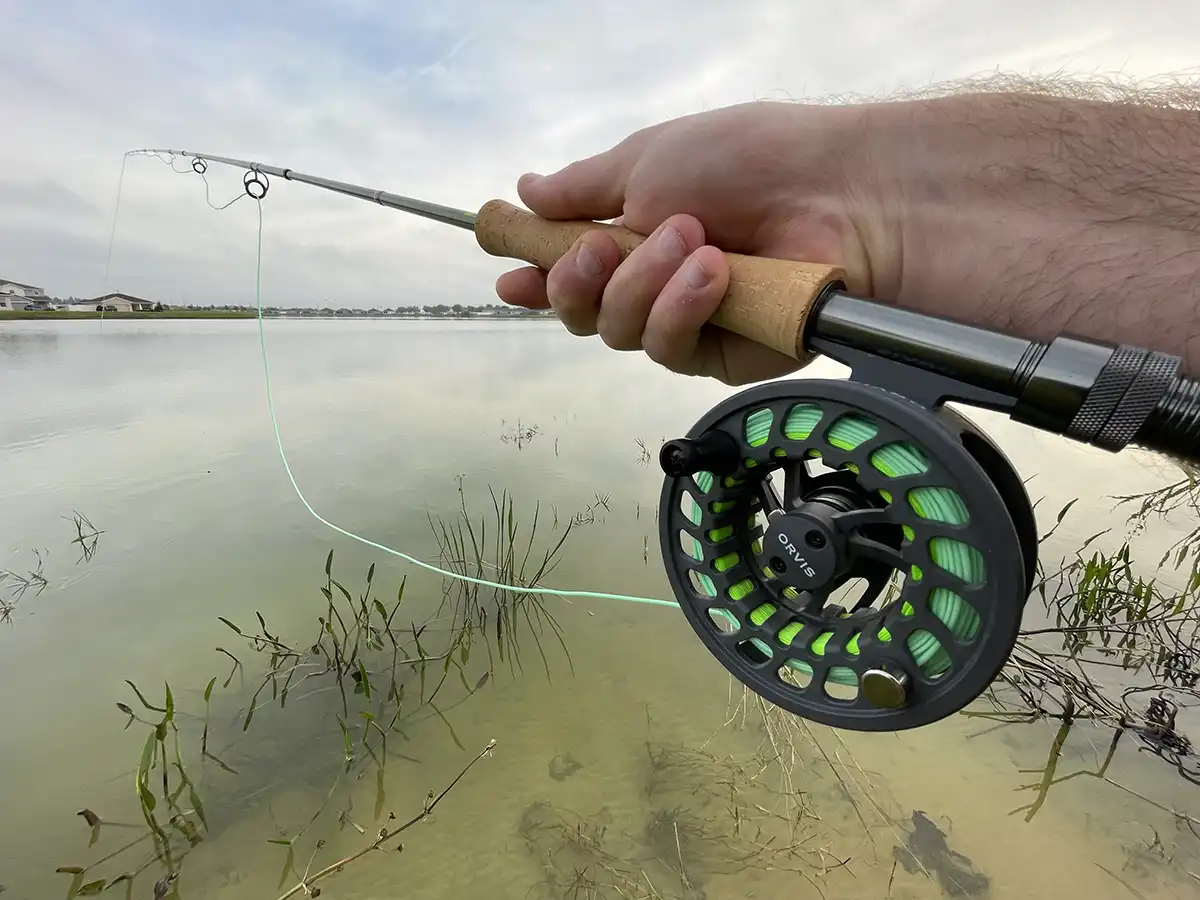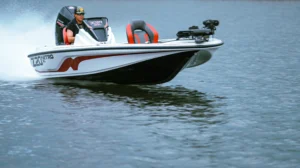Fly fishing for largemouth bass is a blast, but you’ve got to pick your battles to have the greatest success. I’m going to walk through the best flies, seasons and techniques I use to consistently in my personal fishing in Florida to catch largemouth bass on a fly rod.
I’ve been fishing since I was four years old, and I was about twelve when I got my first fly fishing lessons. Old Joe was probably 70 years old when I first met him. According to him, he’d caught so many snook in his life he never wanted to see another one. That story still makes me wonder how many snook you’d have to catch to be tired of them. Regardless, he turned his attention to bass fishing exclusively with a fly rod.
Joe taught me how to use popping bugs, and he made his own. My 12-year-old self didn’t have the patience to learn, so I have to make do with what bass flies I can find commercially. Still, more than three decades later, I’m using the same patterns and techniques Joe taught me.

GEAR FOR FLY FISHING FOR LARGEMOUTH BASS
The fly fishing gear for largemouth bass won’t differ a lot from trout, and it also doesn’t have to be on the upper end of the price spectrum. Mostly you will be beefing up your gear a little and using some bigger flies and poppers most of the time. I use an 8-weight setup with a straight monofilament or fluorocarbon leader. For most of the fish I catch, a 10-pound leader is fine, but I’ll sometimes bump up to 15 pounds if I’m expecting to be around bigger fish or heavier cover.
Purists will certainly scold me for not using a tapered leader, but in my opinion, it’s unnecessary. Florida-strain largemouth bass especially will eat just about anything that looks like it might have been alive at some point and thinks it can fit in its mouth. I find the low-cost option of straight mono or fluoro combined with a loop knot to the fly does just fine and saves you some money.
The setup I’m currently using is the 8-weight Orvis Encounter combo. It’s a 4-piece 9-foot rod perfectly paired with a pre-lined reel and includes a travel case. All you have to do is add a leader and flies.
BEST TIME TO FLY FISH FOR LARGEMOUTH BASS
Without a doubt, early Spring and late Fall are the best times of year to go fly fishing for largemouth bass. I’m in central Florida, and my absolute favorite time of year is mid-February through mid-March when the spring spawn is on.
Second to that is November when the temps are beginning to drop, and fish are feeding heavily. We typically have a cold front or two come through by then, but we’re not getting the consistent systems every three or four days like we do in December through early February.
You can catch largemouth bass on a fly rod year-round, but you’ll need to adjust your approach as the seasons change. Dead winter and the middle of summer are the toughest since bass tend to be more sluggish and hold in deeper locations.
BEST FLIES AND TECHNIQUES FOR LARGEMOUTH BASS
PEAK SEASONS: SPRING AND FALL
In those peak Spring and Fall seasons, you can fish topwater almost all day and catch fish, especially in the rivers. Popping bugs in a bumblebee pattern are my favorite, followed by frog and chartreuse patterns.
Bass, like many predator fish, respond well to contrast. The yellow and black bands of a bumblebee pattern are a perfect contrast, plus it looks like something that would naturally be on the surface if it was unfortunate enough to land there.
The frog and chartreuse patterns are more about introducing green into the mix. Red and green are more visible in the water, and it’s why so many popular bass lures and soft plastics use those colors. To this day, my go-to soft plastics are a red shad plastic worm or pumpkin seed stick bait.
I see a lot of people work their popping bugs by giving a short tug on the line with the rod tip down. The technique I prefer is to hold the line steady and twitch the rod tip up, similar to what you do to make a jig dance. The difference is that the pop I get is more of a “bloop” sound, and it is what drives bass crazy.
I like to pop it, rest two to three seconds, and repeat. Any water movement from wind or current keeps those legs moving during the rest. You can always speed up or slow down as you see what the fish are responding to.
TRANSITION SEASONS: POST SPAWN AND END OF SUMMER
As you move away from the peak seasons, you can still catch plenty of largemouth bass on those same popping bugs using the same technique. The big difference is that as we move further away from the peak months, the topwater bite doesn’t last as long into the day. Focus on the first couple of hours at daybreak and the last couple of hours before dark for the greatest topwater success.
Once the topwater bite drops off, switch over to baitfish patterns and match the predominant species you have. I typically go with a shad or bream pattern. My favorites have been repurposing saltwater flies from Enrique Pulgisi that I use in the Tampa Bay area, however there are others in the space as well, such as Clousers and Deceivers. Of course, tying your own flies to match colors and patterns is a fantastic approach. Regardless, I look for patterns that primarily include contrast and some shade of green.
You’ll have to experiment to find what depth you need to let the fly sink to for the best action. I’ll usually fish these flies anywhere from just under the surface to around 4 feet deep. Keep in mind that the lower you let it sink, the slower you’ll have to work it on a floating line.
OFF PEAK SEASONS: SUMMER AND WINTER
Up until this point, there’s no need to change the gear you’re using. However, if you’re going to fly fish for largemouth bass in the winter and summer, you’ll need to adjust. I’d stick with the same baitfish patterns, possibly introduce weighted crayfish patterns if they’re a food source on the water you’re fishing and deep Clousers. The key here is switching to a sinking line to get those baits close to or on the bottom.
As far as technique goes, work them slowly. With a baitfish pattern, I like to give a short, sharp twitch and let the bait sink back down. What I’m trying to mimic is a dying baitfish that’s not going to cost the bass much energy to chase down and consume.
Of course, if you see actively feeding fish or it’s a peak feeding period, experiment with your presentation until you start triggering strikes.
For the crayfish pattern, I like to bump it along the bottom with an occasional short, sharp twitch to try and trigger a reaction bite.
You can still catch some topwater action early in the day during the summer. In my experience, you have from just before daybreak to about an hour after sunrise. The last hour of the day can also be productive. Once the water warms up and the dissolved oxygen lowers, the fish get sluggish and aren’t as willing to pursue a surface popper. If the body of water you’re fishing has moving water, target current breaks in areas of higher flow where the water is cooler and the oxygen is higher.
Winter topwater is tough, but possible. If you get a warming trend between cold fronts, you can sometimes find a topwater bite just ahead of the next front. I look for wind-protected areas, preferably with a dark bottom that will hold the water temperature a couple of degrees warmer. If you can combine that near a new moon, a midday major feeding period, and there’s bait in the area, there’s a good chance you’ll find actively feeding bass.
FINAL THOUGHTS
One of the reasons I love fly fishing for largemouth bass is that it’s not complicated. With a basic setup and a half dozen patterns, you can successfully target largemouth bass all year long. It’s a fun way to catch them, and you don’t have to be as perfect as you do when you’re fly fishing for trout. Even if you don’t fly fish year-round, largemouth bass are a great species to target when you’ve got the urge.















